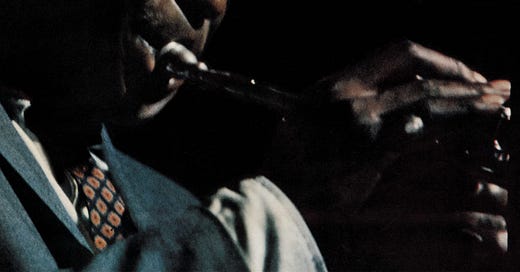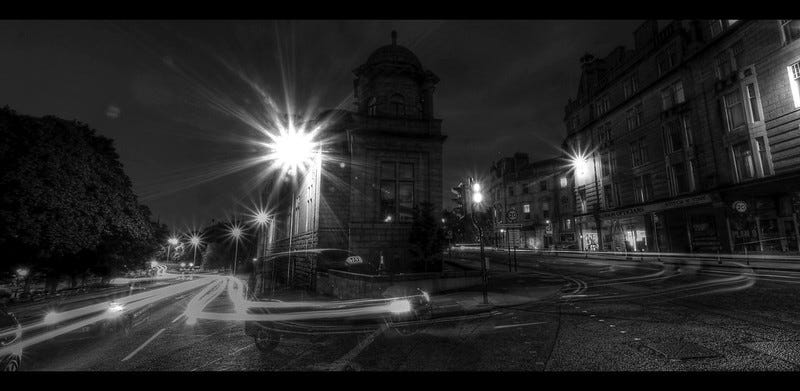In early 2010 I was living in Aberdeen, Scotland, and I distinctly remember walking back from the railway station to my fairly central one-bedroom flat on one occasion. It was dark, it was cold, and it was raining. I was listening to Miles Davis’s Kind of Blue on the previously mentioned Creative Zen Arcade MP3 player I would lose a few months later.
You can imagine the scene to look something like this, without the lens flair from the long exposure. Everything was granite building as the reflection of city lights in puddles. Something about this type of jazz lends itself to raindrops on glass surfaces.
Source: Flickr, PeskyMesky
In 1958 Miles Davis recorded and released Milestones. This album was his first album that explored modal jazz. I’m not going to be able to give you a pithy description of what that is, and I will probably fail the “explain it to a six-year-old” test of proper understanding.
Here’s what Wikipedia says
Modal jazz is jazz that uses musical modes, often modulating among them to accompany the chords instead of relying on one tonal center used across the piece. Although precedents exist, modal jazz was crystallized as a theory by composer George Russell in his 1953 book Lydian Chromatic Concept of Tonal Organization.
This differs from bebop-based jazz in that using those tonal centres; doesn’t run into the problem wherein following them, you know where the tune is going as a listener. Modal jazz doesn’t find itself stuck in a cul-de-sac like that, and the final track on Kind of Blue, ‘Flamenco Sketches’, might be a perfect example.
When people speak of Kind of Blue, they use phrases like “the jazz album that non-jazz fans like” or The Citizen Kane of Jazz and there’s a lot to that, to be honest. It is the first jazz record I ever sat down to listen to and the first I bought. It is one of those albums you always expect to see somewhere in a top 100 albums of all time poll, and it is no surprise it is the highest jazz album on Acclaimed Music’s list.
So why is that? One reason is the band accompanying Davis is legendary - John Coltrane and Julian "Cannonball" Adderley on saxophone, pianist Bill Evans, bassist Paul Chambers, and drummer Jimmy Cobb. This is an exceptional band, and they were at the peak of their powers. OK - that’s impressive, but what are they doing in this song?
Bill Evans is believed1 to have had significant input in how ‘Flamenco Sketches’ came to be. He wrote in the liner notes that;
Miles conceived these settings only hours before the recording dates…. ‘Flamenco Sketches’ consists of five scales, each played "as long as the soloist wishes until he has completed the series.
What that became was a piece of music that isn’t showy or outrageous. It doesn’t need to be; it is unpretentious, relaxed and soothing. A decade later, Miles Davis was recording material almost a 180° flip of that. It keeps with the slow and steady pace of what comes before it, no doubt as it was the first song on the album committed to tape. The instruction for each soloist in the five pieces is to dictate tempo and mood within that structure. Rather than being able to describe the sounds mathematically, it is easier to invoke colours. Blue is a melancholic colour, and its shades darken until the point where blue becomes black, like on a post-Brexit UK passport, is indistinguishable.
‘Flamenco Sketches’ isn’t black, though, it may invoke sadness, but there’s no despair; there’s even a hint of optimism to be found weaving through it in the trilling of the solos - especially those of Cannonball Adderley that reach for the stratosphere around five minutes in for a brief few seconds. Yes, it is much like your team making an unexpected run to the semi-finals and suffering a bitter defeat; you can take solace that they did better than expected and are young enough to go one better next time.
As for going one better next time for Miles Davis and his band, you can argue they don’t quite reach the heights of Kind of Blue again - they do pack a punch over the next decade. Davis gives us Sketches of Spain, Miles Smiles and In A Silent Way. Coltrane would provide us with Giant Steps, My Favorite Things and A Love Supreme. Evans would record Sunday at the Village Vanguard and Waltz for Debby.
It is fair to say that it represents a body of work that at least matches Orson Welles’s post-Citizen Kane output.
He doesn’t get a credit in the liner notes for the arrangement, though many suspect it is him that did the arranging. Mainly as his 1958 album as a bandleader -Everybody Digs Bill Evans, has a very similar piano arrangement on it,







